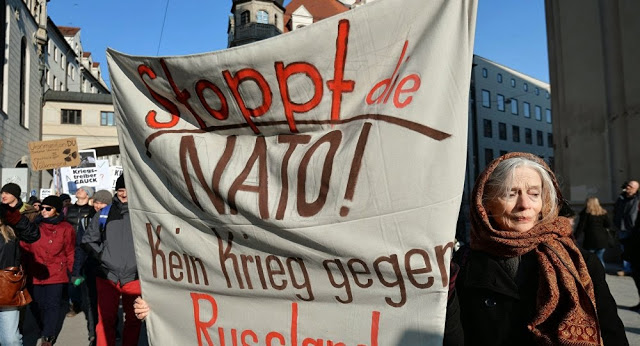Russian strategic bombers now fly long-range patrols near the coast of the US and its NATO allies, while Russian missile tests and military exercises involving simulated use of nuclear weapons raise the specter of nuclear war. The US responds as its defense analysts discuss options for boosting nuclear deterrence in Europe to counter Russian threats.
President Vladimir Putin unambiguously warned the West in August 2014, as the fighting raged in eastern Ukraine, not to forget that “Russia is not to be messed with. I want to remind you that Russia is one of the largest nuclear powers.”
All of this has been interpreted in Europe and the US as aggressive posturing intended to intimidate the West. But inside Russia there is a different conversation. In a recent article in the highly regarded Russian defense weekly Voenno-Promyshelnnyi Kuryer (VPK) (Military Industrial Courier), prominent Russian defense expert retired Col. Mikhail Khodarenok draws alarming — for Russia — conclusions about the Russia-NATO military balance and the Russian military’s prospects in a hypothetical conflict with the West.
The war in eastern Ukraine, he writes, is essentially a fight between two Soviet-era armies. “One is the 1991 army (the Ukrainian armed forces); the other is the slightly modernized version of the very same Soviet Army — it is just better prepared tactically, staffed by more skilled personnel, and better commanded.”
What would happen if the Ukrainian Army was joined by “volunteers” from the US and Western Europe and their standard weapons and other equipment, he asks.
“Are the [Russian-backed separatists] going to last long if another, qualitatively different adversary enters the war?” No, they will be “lucky to last a few hours,” he claims. And if the conflict escalates and both the Russian military and NATO become directly involved with conventional weapons, he believes the West will prevail because “the Russian armed forces unfortunately still can boast only of very few qualitative differences from its 1991 predecessor. For the most part, it lacks the 21st century cutting-edge technology.”
The new tanks in the Red Square parade look impressive, but the reality of the Russian military that Khodarenok paints is less so. Its fleet of fighter aircraft is obsolete; the Black Sea Fleet based in Crimea is essentially “a museum;” and the Russian military has deficient logistics.
Against this backdrop, Moscow’s nuclear bravado appears in a different light: as a warning to the US and NATO to refrain from a military intervention in Crimea and eastern Ukraine. The rhetoric is intended as a political message, not a military one: It is targeted at the West to impress upon its leaders the exceptional importance of this region for Russia’s national security interests.
Speaking in April, the commander of Russia’s Strategic Missile Forces, Col. Gen. Sergei Karakayev, reiterated that the message was political. Karakayev said the alert level of the forces he commands had not been increased since the start of the crisis, and the guidance systems of his missiles still had “zero flight programs” as mandated by a 1994 agreement between Russia and the US not to target each other.
There have been no reports of Russian tactical nuclear forces being put on alert. While the dual-capable short-range Iskander missiles were deployed in the Kaliningrad region and the Tu-22M3 medium bombers were transferred to Crimea, there have been no reports of the delivery of nuclear weapons to these regions.
Once, Soviet and US Cold War-era leaders fully understood the consequences of a nuclear exchange; both realized there would be no winners. Both understood the psychological pressure of having to make life and death decisions for the entire world in a matter of minutes. But is the new generation of Russian and US leaders as cognizant of these dangers?
The US and its NATO allies have made clear they are not looking for a military confrontation with Russia. But the escalation of nuclear rhetoric, now on both sides, could lead to unintended consequences. Anyone who thinks that an unintended nuclear scenario over Ukraine is far-fetched should remember that less than two years ago, the US and Russia were discussing how to expand trade, find a compromise on missile defense and further cut their nuclear arsenals.
The sudden return of the specter of nuclear war — whether intentional or accidental — reminds us that peace between the US and Russia is more fragile than previously thought; profound misunderstandings between Washington and Moscow carry grave dangers.
Last month’s meeting of US Secretary of State John Kerry in Sochi with Putin and Foreign Minister Sergey Lavrov was a step in the right direction, but discussions between Washington and Moscow seem to have stalled. That is a shame; more dialogue is needed to defuse tension and tone down irresponsible statements on both sides about nuclear weapons. It should be done without delay.
Arbatov is Scholar in Residence, Carnegie Moscow Center and former Deputy Chair of the Duma Defense Committee.










